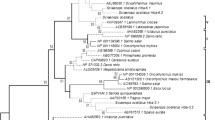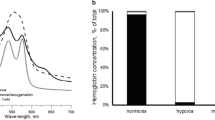Summary
This study concerns the adaptation of oxygen transporting function of carp blood to environment hypoxia, tracing the roles played by erythrocytic cofactors, inorganic cations, carbon dioxide and hemoglobin multiplicity.
Carp acclimated to hypoxia (\(P_{O_2 }\)∼30 mmHg) display striking increases in blood oxygen affinity compared to normoxic (\(P_{O_2 }\)=120–150 mm) specimens (P 50's are 3.0 and 7.0 mm, respectively, at pH 7.9 and 20°C). This correlates with a marked decrease in erythrocytic concentrations of NTP (nucleoside triphosphates) (Figs. 1, 2, Table 1), permitting investigation of the time-course of the response (Fig. 3). That GTP (guanosine triphosphate) plays a greater role than ATP in the allosteric regulation of blood oxygen affinity, follows from greater decreases in its concentration during hypoxia, and its greater effect on oxygen affinity of the hemoglobin (Figs. 1, 5). It is furthermore shown that divalent cations (which complex with NTP) inhibit the regulatory role of GTP on O2 affinity to a lesser extent than that of ATP (Fig. 7). However, the divalent cation, Mg2+, occurs in similarly high concentrations in the erythrocytes of hypoxic and normoxic fish (Table 1). CO2 specifically depresses the O2 affinity of carp hemoglobin, but below pH 8.3, its effect is obliterated by ATP and GTP suggesting that the β chains are the main sites for CO −2 binding. Four carp hemoglobin components are isolated and their oxygen-binding properties compared with those of the cofactor-free hemolysate (Figs. 4, 8, 9). The results are discussed comparatively with special reference to hemoglobin function in fish and mammals.
Similar content being viewed by others
References
Antonini, E., Brunori, M.: Hemoglobin and myoglobin in their reactions with ligands. Amsterdam: North-Holland 1971
Arnone, A.: Mechanism of action of hemoglobin. Ann. Rev. Med.25, 123–130 (1974)
Bauer, C.: Antagonistic influence of CO2 and 2,3 diphosphoglycerate on the Bohr effect of human haemoglobin. Life Sci.8, 1041–1046 (1969)
Benesch, R., Benesch, R.E., Yu, C.I.: Reciprocal binding of oxygen and diphosphoglycerate by human hemoglobin. Proc. Natl. Acad. Sci. USA59, 526–532 (1968)
Benesch, R.E., Benesch, R., Yu, C.I.: The oxygenation of hemoglobin in the presence of 2,3 diphosphoglycerate. Effect of temperature, pH, ionic strength, and hemoglobin concentration. Biochemistry8, 2567–2571 (1969)
Berger, H., Jänig, G.-R., Gerber, G., Ruckpaul, K., Rapoport, S.M.: Interaction of haemoglobin with ions. Interactions among magnesium, adenosine 5-triphosphate, 2,3-biphosphoglycerate, and oxygenated and deoxygenated human haemoglobin under simulated intracellular conditions. Eur. J. Biochem.38, 553–562 (1973)
Berman, M., Benesch, R., Benesch, R.E.: The removal of organic phosphates from hemoglobin. Arch. Biochem. Biophys.145, 236–239 (1971)
Bunn, H.F., Ransil, B.J., Chao, A.: The interaction between erythrocyte organic phosphates, magnesium ion and hemoglobin. J. Biol. Chem.246, 5273–5279 (1971)
Coates, M.: Studies on the interaction of organic phosphates with haemoglobin in an amphibian (Bufo marinus), a reptile (Trachydosaurus rugosus) and man. Aust. J. Biol. Sci.28, 367–378 (1975)
Chanutin, A., Curnish, R.R.: Effect of organic and inorganic phosphates on the oxygen equilibrium of human erythrocytes. Arch. Biochem. Biophys.121, 96–102 (1967)
Christoforides, C., Hedley-Whyte, J.: Effect of temperature and hemoglobin concentration on solubility of O2 in blood. J. Appl. Physiol.27, 592–596 (1969)
Costello, A.J.R., Marshall, W.E., Omachi, A., Henderson, T.O.: ATP binding to human hemoglobin in the presence and absence of magnesium ions investigated with31P NMR spectroscopy and ultrafiltration. Biochim. Biophys. Acta491, 469–472 (1977)
Dejours, P.: Principles of comparative respiratory physiology. Amsterdam: North-Holland 1975
Duhm, J.: Effects of 2,3-diphosphoglycerate and other organic phosphate compounds on oxygen affinity and intracellular pH of human erythrocytes. Pflügers Arch.326, 341–356 (1971)
Field, J.B., Elvehjem, C.A., Juday, C.: A study of the blood constituents of carp and trout. J. Exp. Biol.48, 261–270 (1968)
Fourie, F. le R., Van Vuren, J.H.J.: A seasonal study on the hemoglobins of carp (Cyprinus carpio) and yellowfish (Barbus holubi) in South Africa. Comp. Biochem. Physiol.55B, 523–525 (1976)
Garey, W.F., Rahn, H.: Gas tensions in tissues of trout and carp exposed to diurnal changes in oxygen tension of the water. J. Exp. Biol.52, 575–582 (1970)
Geoghegan, W.D., Poluhowich, J.J.: The major erythrocytic organic phosphates of the American eelAnguilla rostrata. Comp. Biochem. Physiol.49B, 281–290 (1974)
Gillen, R.G., Riggs, A.: The hemoglobins of a fresh-water teleost,Cichlasoma cyanoguttatum (Baird and Girard). I. The effects of phosphorylated organic compounds upon the oxygen equilibria. Comp. Biochem. Physiol.38B, 585–595 (1971)
Gillen, R.G., Riggs, A.: Structure and function of the hemoglobins of the carp,Cyprinus carpio. J. Biol. Chem.247, 6039–6046 (1972)
Greaney, G.S., Powers, D.A.: Cellular regulation of an allosteric modifier of fish haemoglobin. Nature270, 73–74 (1977)
Hilse, K., Braunitzer, G.: Die Aminosäuresequenz der α-Ketten der beiden Hauptkomponenten des Karpfenhämoglobins. Hoppe-Seyler's Z. Physiol. Chem..349, 433–450 (1968)
Hunt, B.J., Manery, J.F.: Use of ion-exchange resin in preparing erythrocytes for magnesium determinations. Clin. Chem.16, 269–273 (1970)
Isaacks, R. E., Kim, H.D., Bartlett, G.R., Harkness, D.R.: Inositol pentaphosphate in erythrocytes of a freshwater fish, Piraracú (Arapaima gigas) Life Sci.20, 987–990 (1977)
Johansen, K., Lykkeboe, G., Weber, R.E., Maloiy, G.M.O.: Respiratory properties of blood in awake and estivating lungfish,Protopterus amphibius. Respir. Physiol.27, 335–345 (1976)
Kilmartin, J.V., Rossi-Bernardi, L.: Inhibition of CO2 combination and reduction of the Bohr effect in hemoglobin chemically modified at its α-amino groups. Nature222, 1243–1246 (1969)
Lomholt, J.P., Johansen, K.: Hypoxia acclimation in carps. How it affects O2 uptake, ventilation and O2 extraction from water. Physiol. Zool. (in press) (1979)
Lykkeboe, G., Johansen, K., Maloiy, G.M.O.: Functional properties of hemoglobins in the teleostTilapia grahami. J. comp. Physiol.104, 1–11 (1975)
Lykkeboe, G., Weber, R.E.: Changes in the respiratory properties of the blood in the carp,Cyprinus carpio, induced by diurnal variation in ambient oxygen tension. J. comp. Physiol.128, 117–125 (1978)
Niesel, W., Thews, G.: Ein neues Verfahren zur schnellen und genauen Aufnahme der Sauerstoffbindungskurve des Blutes und konzentrierten Hämoproteinlösungen. Pflügers Arch.273, 380–395 (1961)
O'Brien, D., Ibbott, F.: Microbiochemical techniques in pediatrics. In: Todd-Sanford clinical diagnosis by laboratory methods, Davidsohn, I., Wells B.B. (eds.), pp. 503–520. Philadelphia: Saunders 1962
O'Sullivan, W.J., Perrin, D.D.: The stability constants of metaladenine nucleotide complexes. Biochemistry3, 18–26 (1964)
Pennelly, R.R., Tan-Wilson, A.L., Noble, R.W.: Structural states and transitions of carp hemoglobin. J. Biol. Chem.250, 7239–7244 (1975)
Perutz, M.F.: Stereochemistry of cooperative effects in haemoglobin. The Bohr effect and combination with organic phosphates. Nature228, 734–739 (1970)
Peterson, A.J., Poluhowich, J.J.: The effects of organic phosphates on the oxygenation behaviour of eel multiple hemoglobins. Comp. Biochem. Physiol.55A, 351–354 (1976)
Qvist, J., Weber, R.E., De Vries, A.L., Zapol, W.M.: pH and haemoglobin oxygen affinity in blood from the antarctic codDissostichus mawsoni. J. Exp. Biol.67, 77–88 (1977)
Rose, I.A.: The state of magnesium in the cell as estimated from the adenylate kinase equilibrium. Proc. Natl. Acad. Sci. USA61, 1079–1086 (1968)
Rossi-Bernardi, L., Roughton, E.J.W.: The specific influence of carbon dioxide and carbonate compounds in the buffer power and Bohr effects in human haemoglobin solutions. J. Physiol.189, 1–29 (1967)
Spaargaren, D.H.: On the osmotic and ionic regulation in blood, bile and tissues of threePleuronectes species. Neth. J. Sea Res.10, 479–490 (1976)
Tan, A.L., De Young, A., Noble, R.W.: The pH dependence of the affinity, kinetics and cooperativity of ligand binding to carp hemoglobin,Cyprinus carpio. J. Biol. Chem.247, 2493–2498 (1972)
Tan, A.L., Noble, R.W., Gibson, Q.H.: Conditions restricting allosteric transitions in carp hemoglobin. J. Biol. Chem.248, 2880–2888 (1973)
Wallas, E.: Stability constants of metal complexes with mononucleotides. Acta Chem. Scand.12, 528–536 (1958)
Weber, R.E.: Functional interaction between fish hemoglobin erythrocytic nucleoside triphosphates and magnesium. Acta Physiol. Scand.102, 20A-21A (1978)
Weber, R.E., Hemmingsen, E.A., Johansen, K.: Functional and biochemical studies of penguin myoglobin. Comp. Biochem. Physiol.49B, 197–214 (1974)
Weber, R.E., Lykkeboe, G., Johansen, K.: Biochemical aspects of the adaptation of hemoglobin-oxygen affinity of eels to hypoxia. Life Sci.17, 1345–1350 (1975)
Weber, R.E., Lykkeboe, G., Johansen, K.: Physiological properties of eel haemoglobin: Hypoxic acclimation, phosphate effects and multiplicity. J. Exp. Biol.64, 75–88 (1976a)
Weber, R.E., Sullivan, B., Bonaventura, J., Bonaventura, C.: The hemoglobin system of the primitive fish,Amia calva: isolation and functional characterization of the individual hemoglobin components. Biochim. Biophys. Acta434, 18–31 (1976b)
Weber, R.E., Wood, S.C.: Effects of erythrocytic nucleoside triphosphates on oxygen equilibria of composite and fractionated hemoglobins from the facultative air-breathing Amazonian catfish,Hypostomus andPterygoplichthys. Comp. Biochem. Physiol. (in press) (1978)
Weber, R.E., Wood, S.C., Davis, B.J.: Acclimation to hypoxic water in facultative air-breathing fish. Blood oxygen affinity and allosteric cofactors. Comp. Biochem. Physiol. (in press) (1978)
Weber, R.E., Wood, S.C., Lomholt, J.P.: Temperature acclimation and oxygen-binding properties of blood and multiple haemoglobins of rainbow trout. J. Exp. Biol.65, 333–345 (1976c)
Wood, S.C., Johansen, K.: Adaptation to hypoxia by increased HbO2 affinity and decreased red cell ATP concentration. Nature237, 278–279 (1972)
Wood, S.C., Johansen, K.: Organic phosphate metabolism in nucleated red cells. Influence of hypoxia on eel HbO2 affinity. Neth. J. Sea Res.7, 328–338 (1973)
Wood, S.C., Johansen, K., Weber, R.E.: Effect of ambient PO2 on hemoglobin-oxygen affinity and red cell ATP concentrations in a benthic fish,Pleuronectes platessa. Respir. Physiol.25, 259–267 (1975)
Yamaguchi, K., Kochiyama, Y., Hashimoto, K., Matsuura, F.: Studies on the multiple hemoglobins of eel — I. Absorption spectrum and some properties. Bull. Jap. Soc. Scient. Fish.28, 184–191 (1962)
Yamanaka, H., Yamaguchi, K., Matsuura, F.: Starch gel electrophoresis of fish hemoglobins — II. Electrophoretic patterns of hemoglobin of various fishes. Bull. Jap. Soc. Sci. Fish.31, 833–839 (1965)
Author information
Authors and Affiliations
Rights and permissions
About this article
Cite this article
Weber, R.E., Lykkeboe, G. Respiratory adaptations in carp blood influences of hypoxia, red cell organic phosphates, divalent cations and CO2 on hemoglobin-oxygen affinity. J Comp Physiol B 128, 127–137 (1978). https://doi.org/10.1007/BF00689476
Accepted:
Issue Date:
DOI: https://doi.org/10.1007/BF00689476




